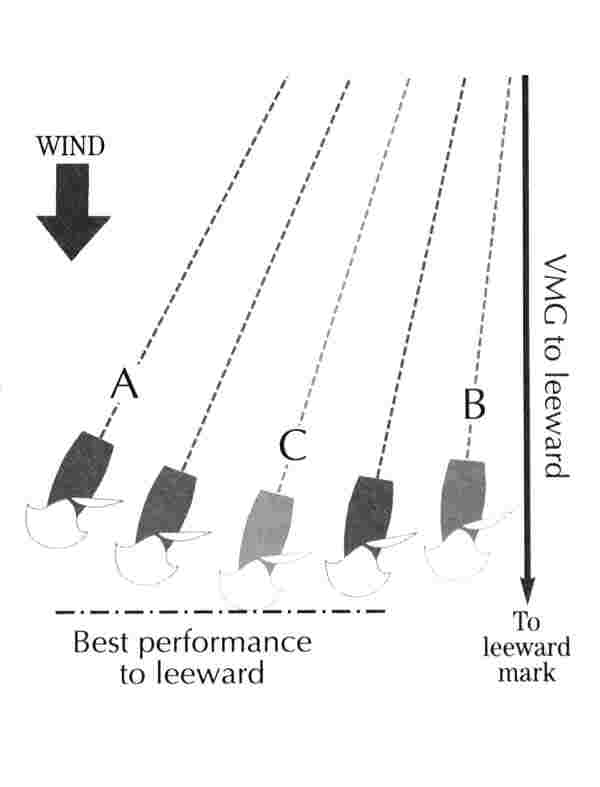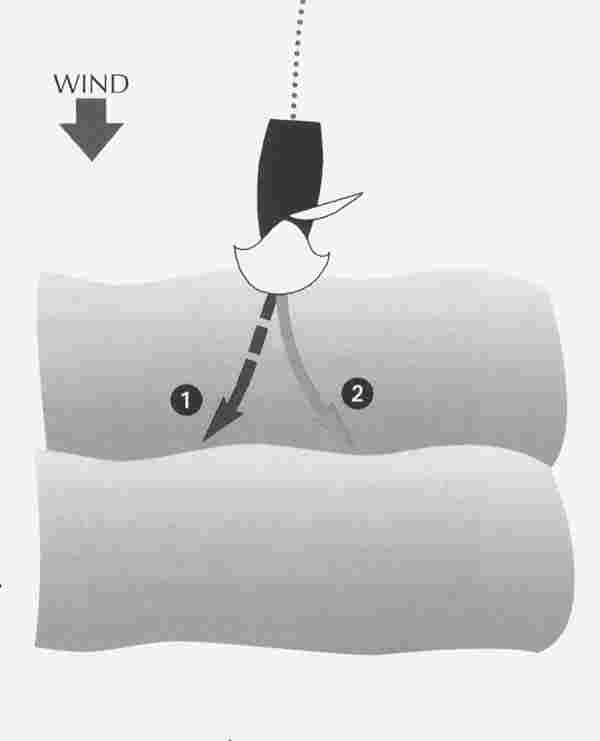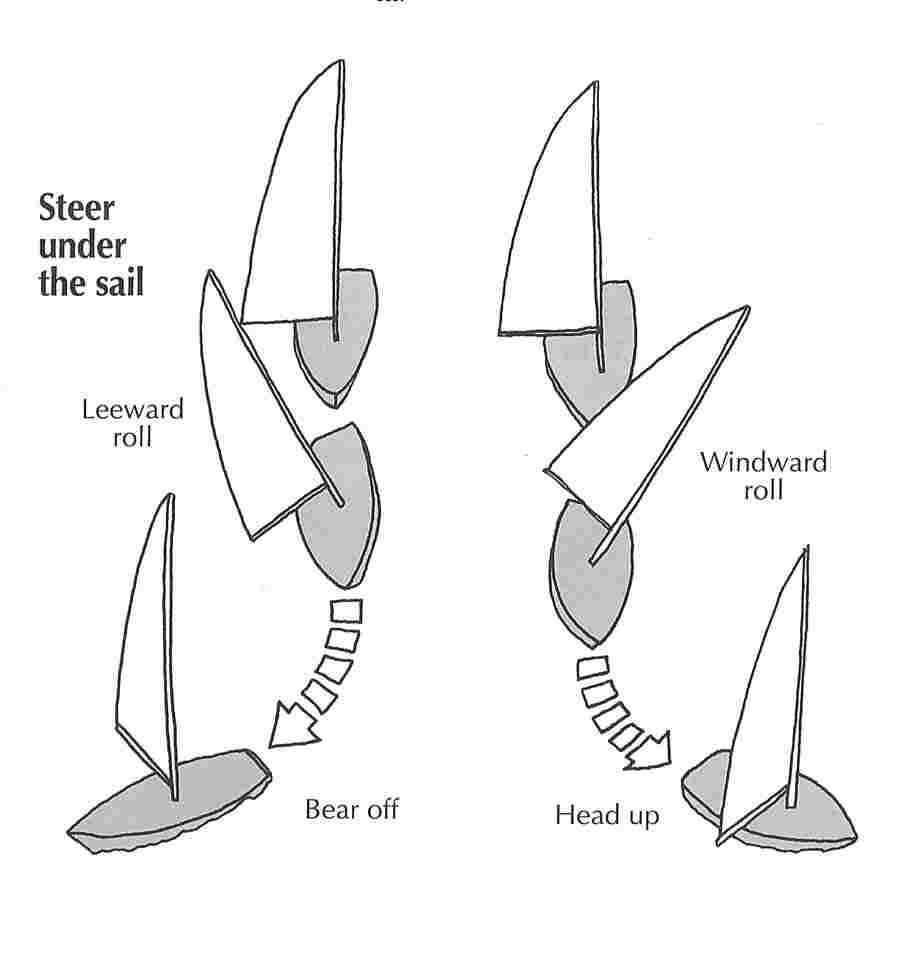

STEERING DOWNWIND -
ON RUNS, STEER BY “FEEL”
By Dave Dellenbaugh
Steering downwind seems easy at first. After all, you just head for the next mark and trim your sails. But it’s not always so simple, at least if you want to go fast.
When you’re on a run, it’s usually more difficult to get into a “groove” than it is when you are beating. That’s because you don’t have the reassuring tug of weather helm or the guiding pressure of apparent wind in your face. As a result, you must work extra hard at steering after you go around the windward mark. Here are some guidelines to remember:
• Tune in to “feel” —The last thing you should do is steer the boat by aiming for the next mark or by dialing in a compass heading. You don’t steer upwind that way, so you shouldn’t do it in a run, either.
Instead, tune in to the “feel” of the boat and use this to guide your steering. There are two basic ways to feel the boat downwind: The first is by sensing the amount of wind pressure you have, and whether this pressure is increasing or decreasing. Gauge this by noticing changes in the boat’s angle of heel or changes in the amount of pull on the helm.
The second way to feel the boat is by trying to estimate changes in your speed (i.e. whether you are accelerating or decelerating). You can gauge this primarily by the sound, look and feel of how your boat is going through the water. (You can also judge your performance relative to nearby boats.)
Once you are able to get a good idea of how your pressure and speed are changing, then it will be much easier to know how to steer.
 |
 |
| When you’re steering on a run, one of the toughest things is to pick the speed and angle that will give you the best performance downwind. If you sail to high (A), you will go fast but you’ll be headed too far from the next mark. If you sail too low (B), you’ll be headed closer to the mark, but you won’t be very fast. There is usually one course (C) that gives you the best combination of speed and heading (i.e. it maximizes your VMG to leeward). On a one-design boat you have to find this “groove” by feel; on a bigger boat you often have instruments to help locate this “target.” | Running in waves: When you’re surfing on a wave, one potential problem is hitting the next wave ahead. Most sailors avoid this problem by heading up (1). If you have enough speed to stay on the wave, however, it’s often better to bear off (2) and go by the lee to gain more ground to leeward. |
• Keep the boat going fast — One of the best rules of thumb, especially in lighter wind, is to err on the fast side. In other words, it’s usually better to sail a little to high and fast than to ail too low and too slow. By maintaining speed, you make the boat more forgiving—that is, it will be easier to keep the boat going well when you get a wind shift, a lull, a set of bad waves, or when you have a mental lapse.
Having a little extra speed will also make it easier to maneuver, like when you are jibing, playing the waves or moving tactically relative to other boats. All these are more difficult when you’re sailing slow.
• Communicate with your sail trimmers—Since the boat often feels mush y to the helmsperson, he or she should look for help from other members of the crew. The person who may have the best sense of wind pressure changes is the spinnaker trimmer (on boats with chutes, of course).
Because he or she is holding the spinnaker sheet, the spinnaker trimmer has a direct feel for the amount of pressure (i.e. pull) in the sail. In addition, he or she also has a good view of the chute and can see if the sail is starting to droop or beginning to fill and lift.
As a result, it’s very important for the helmsperson and chute trimmer to maintain a constant dialogue about whether they think the pressure is building or dropping. For example, does the trimmer think you should head lower to burn speed or heat up to build speed? This has a huge impact on steering.
• Reduce rudder drag — Unlike beating, where a bit of helm in the rudder is good for feel and lift, when you are running you mostly want a neutral helm to minimize drag. Therefore, you should position your crew weight to heel the boat so when you let go of the wheel or tiller the boat keeps going straight.
 |
| When you’re running in windy and/or wavy conditions, the best way to stay in control and going fast is to steer your boat under the sail(s). If your rig rolls to leeward (left), bear off to get the hull under the mast. If you rig rolls to windward (right), head up to get the hull under the mast. The idea is to keep the mast roughly vertical by steering your boat so the bottom of the mast stays under the top. It’s like trying to balance a long stick vertically with one end in the palm of your hand. |
In addition, except in wavy conditions, you should minimize rudder movement to reduce turbulence. Keep your helm still and use your weight and sail trim as much as possible to steer.
These are some of the many things to keep in mind when steering downwind. See future articles to get tips on this subject from some of the world’s top sailors.
Dave is a two-time America’s Cup veteran who publishes a newsletter Speed & Smarts. For a subscription call: 800-356-2200.